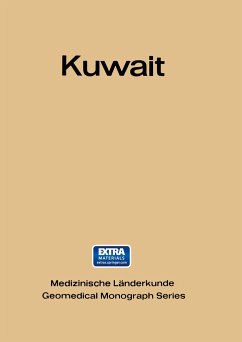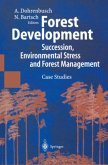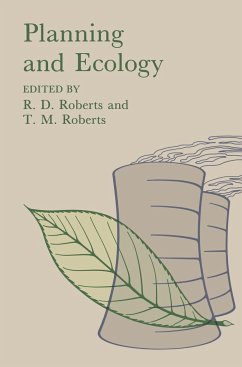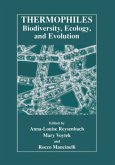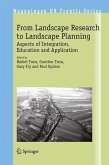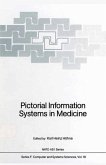- Broschiertes Buch
- Merkliste
- Auf die Merkliste
- Bewerten Bewerten
- Teilen
- Produkt teilen
- Produkterinnerung
- Produkterinnerung
The developing countries are recelvmg generous Government Offices, and commercial organizations attention from experts, officials and academics drawn deserve our sincere thanks for their attention to our from a wide spectrum of specialist interests. Some of this many enquiries. In particular, we would like to thank effort is directed towards a solution of several of the the officials of the Planning Board and the Central world's most pressing problems, including ill-health, Statistical Office, Kuwait Municipality, University of under-nourishment, and rapid population growth, but Kuwait, and…mehr
Andere Kunden interessierten sich auch für
![Winning the Games Scientists Play Winning the Games Scientists Play]() C. J. SindermannWinning the Games Scientists Play41,99 €
C. J. SindermannWinning the Games Scientists Play41,99 €![Forest Development Forest Development]() Forest Development41,99 €
Forest Development41,99 €![Planning and Ecology Planning and Ecology]() R. D. RobertsPlanning and Ecology41,99 €
R. D. RobertsPlanning and Ecology41,99 €![Thermophiles: Biodiversity, Ecology, and Evolution Thermophiles: Biodiversity, Ecology, and Evolution]() Thermophiles: Biodiversity, Ecology, and Evolution77,99 €
Thermophiles: Biodiversity, Ecology, and Evolution77,99 €![From Landscape Research to Landscape Planning From Landscape Research to Landscape Planning]() Bärbel Tress / Gunther Tres / Gary Fry / Paul Opdam (eds.)From Landscape Research to Landscape Planning169,99 €
Bärbel Tress / Gunther Tres / Gary Fry / Paul Opdam (eds.)From Landscape Research to Landscape Planning169,99 €![Pictorial Information Systems in Medicine Pictorial Information Systems in Medicine]() Pictorial Information Systems in Medicine41,99 €
Pictorial Information Systems in Medicine41,99 €![Morphologie der Papillae fungiformes Morphologie der Papillae fungiformes]() H. W. BeckersMorphologie der Papillae fungiformes54,99 €
H. W. BeckersMorphologie der Papillae fungiformes54,99 €-
-
-
The developing countries are recelvmg generous Government Offices, and commercial organizations attention from experts, officials and academics drawn deserve our sincere thanks for their attention to our from a wide spectrum of specialist interests. Some of this many enquiries. In particular, we would like to thank effort is directed towards a solution of several of the the officials of the Planning Board and the Central world's most pressing problems, including ill-health, Statistical Office, Kuwait Municipality, University of under-nourishment, and rapid population growth, but Kuwait, and the Kuwait Oil Company. The following other workers are more concerned with the less immedi individuals deserve our special thanks: Mr. Ahmad al ate but nonetheless very significant theoretical aspects Duaij, Mr. Fouad al Hussaini, Mr. Hamid Shwaib, Mr. of the developing countries. This book is an attempt to Abdulaziz aI-Hamdan, Mr. Fouad Haddad, Mr. Ahmad bridge the gap between these two approaches. al-Haj, Mr. Marwan 'Adra', Mr. Muhammad Sukhon, At this present juncture in time we are faced with Professor Abdul Fattah Ismail, Professor Dawlat Sadiq, the realization that the experience of Europe or North Professor Muhammad Mutwalli, Dr. Muhammad Shar nubi, His Excellency Ibrahim Shatti, Dr. Noel Brehony, America may be of limited assistance in the interpretation Professor W. B. Fisher, Dr. John Brebner, Dr. Alan of current trends in the developing world. Not only is Horan, Mrs.
Hinweis: Dieser Artikel kann nur an eine deutsche Lieferadresse ausgeliefert werden.
Hinweis: Dieser Artikel kann nur an eine deutsche Lieferadresse ausgeliefert werden.
Produktdetails
- Produktdetails
- Medizinische Länderkunde Geomedical Monograph Series 4
- Verlag: Springer / Springer Berlin Heidelberg / Springer, Berlin
- Artikelnr. des Verlages: 978-3-642-65174-8
- Softcover reprint of the original 1st ed. 1971
- Seitenzahl: 144
- Erscheinungstermin: 15. November 2011
- Englisch
- Abmessung: 297mm x 210mm x 9mm
- Gewicht: 394g
- ISBN-13: 9783642651748
- ISBN-10: 3642651747
- Artikelnr.: 39508097
- Herstellerkennzeichnung Die Herstellerinformationen sind derzeit nicht verfügbar.
- Medizinische Länderkunde Geomedical Monograph Series 4
- Verlag: Springer / Springer Berlin Heidelberg / Springer, Berlin
- Artikelnr. des Verlages: 978-3-642-65174-8
- Softcover reprint of the original 1st ed. 1971
- Seitenzahl: 144
- Erscheinungstermin: 15. November 2011
- Englisch
- Abmessung: 297mm x 210mm x 9mm
- Gewicht: 394g
- ISBN-13: 9783642651748
- ISBN-10: 3642651747
- Artikelnr.: 39508097
- Herstellerkennzeichnung Die Herstellerinformationen sind derzeit nicht verfügbar.
The relation of Kuwait's development to Europe and Far East.- Discovery of oil reserves outside the Middle East.- Arab nationalism.- Great Britain's responsibility.- Inapplicability of laws and generalizations of developed world.- General lessons of value to others.- Kuwait a testing ground.- 1. Urbanization and Population Growth in the Middle East.- 1. Definitions.- General statements on nature and causes of urbanization.- Historical connections.- Development of civilisations.- Technical innovations.- Sources of labour.- Population increase, food supplies, general educational advances.- 2. Middle East Urbanization: Extent andSpecial Characteristics.- United Nations's statistics.- 3. Levels of Urbanization in the Middle East.- 4. Elements Peculiar to the Urbanization of the Middle East.- Social and political urbanization.- Defence role.- Religion.- Oil.- Investment capital.- Israel.- Foreign aid.- 5. Conclusion.- II. The Urbanization of Kuwait. Prosperity alternating with hardship.- 1. The Environment. Physical geography.- a) Summer.- b) Winter.- c) Daily weather.- 2. Water Resources.- a) Occurrence.- b) Development.- 3. Power.- 4. Agriculture.- a) Farmers.- b) Nomads.- 5. Fishing.- a) Pearling.- b) Fishing.- 6. Mineral Resources Industries.- Industries.- Distribution of labour force.- Restriction of economic opportunity.- III. The Early History of Kuwait.- IV. The Economic Development of Kuwait.- V. Population Growth in Kuwait. Twelve hundred per cent increase in 60 years.- 1. Introduction.- Preponderance of non-Kuwaitis.- Nationality law.- Duality of national life.- 2. Population Expansion by Immigration.- a) War-time immigration.- b) Post-war immigration.- c) Factors involved in immigration.- d) The Alien population 1957-1965.- aa) Sex ratios.- bb) Agestructure.- e) Permanency of migration to Kuwait.- f) Arrivals after 1965.- 3. Population Expansion by Natural Increase. Introduction.- a) Vital statistics in Kuwait.- b) Natality, mortality and the populationcycle.- c) Health facilities in Kuwait.- aa) Growth.- bb) Effect.- d) Age structure of the Kuwait population.- aa) The Kuwaitis.- bb) The Non-Kuwaitis.- e) Natality and fertility.- aa) Kuwaitis.- bb) Non-Kuwaitis.- f) Mortality.- aa) Kuwaitis.- bb) Non - Kuwaitis.- 4. Conclusions - Natural Increase.- a) Kuwaitis.- b) Non-Kuwaitis.- VI. The Ecology of Daily Life.- A. The Rural Community.- Agriculture.- Water resources.- Pastoral nomadism.- Cultural legacy of the Badu.- Religion, fasts and feasts.- Emphasis on kinship.- Hospitality, manners and modes.- B. The Urban Community.- Post-War Expansion of the Built up Area.- 1. Kuwait City Before Oil Discoveries.- a) Extent.- b) Internal characteristics and differentiation.- 2. Kuwait City after the Discovery of Oil.- Rising revenues and immigration.- 3. The Government Land Purchase Scheme.- 4. Planning and Urban Expansion.- a) The 1952 plan.- b) Physical expansion of the city structure.- c) Subsequent plans.- 5. The Contemporary City.- a) The Old City.- b) The Kuwait neighbourhoods.- c) Hawalli and Salimiya.- d) Abruq Khaitan and Farwaniya.- e) Ahmadi and Fahahil.- C. Population Distribution and Density within the Urban Areas.- 1. Changing Patterns of Population Distribution.- a) Before the first census.- b) Effects of oil discoveries.- c) Population distribution in 1957.- d) Population distribution in 1965.- D. Population Composition and Social Areas within Kuwait.- 1. "Western" and "non-Western" Cities.- 2. Land Use and Urban Ecology.- a) Methods.- b) Selection of variables.- 3. The Distribution of IndividualVariables.- a) Kuwaitis and non-Kuwaitis.- b) Illiterates.- c) Employees in construction.- d) Professional and temnical workers.- e) Administrative workers.- 4. The Analysis of Groups of Variables.- a) Method.- b) Variables.- 5. The Factors: Their Composition and Distribution.- a) Factor composition.- b) The distribution of factors throughout Kuwait.- 6. The Geographic Distribution of Individual Factors.- 7. Combinations of all 3 Factors.- a) Group 1.- b) Group 2.- c) Group 3.- d) Group 4.- 8. Factor Analysis and the Structure of Kuwait City.- 9. Social Areas in Kuwait City.- a) The Old City and other areas of immigrant invasion.- b) Areas under construction with low-status immigrants.- c) Strongly Kuwaiti areas.- 10. International Parallels.- 11. Conclusion.- VII. Health and Disease.- 1. Introduction.- a) Pseudo-urbanization.- b) The health of the Badu.- c) Effects of urbanization.- d) Integration of planning for social and environmental manges.- e) The importance of integrating disciplines beyond fringe of medicine.- f) Adaptation of the individual to meet the new stresses.- g) Alterations in disease patterns.- h) Definition of Medical Geography.- 2. Specific Problems of Kuwait.- a) Training for responsibility.- b) Infectious disease.- c) Infant gastro-enteritis.- d) Kuwait as an epidemiological listening post.- e) Genetic disease.- f) Environmental influences.- g) Blindness.- VIII. Preventive Medicine in Kuwait.- 1. Preventive Medical Service.- a) Establishment: urban planning: water supplies; killing of animals.- b) Structure of Ministry of Public Health.- c) Growth of services.- d) Communications.- e) Health education.- f) Inspection of buildings and regulations.- g) Private industrially financed medical services of the oil companies.- 2. Infectious Diseases.- a)Comparison with other geographic areas.- b) Leprosy.- c) Hepatitis.- d) Rabies.- e) Malaria.- f) Poliomyelitis.- g) Bacillary Dysentery.- h) Amoebic Dysentery.- i) Worms.- j) Schistosomiasis.- 3. School Medical Services.- a) School population.- b) Development of service.- c) Epidemiology.- d) Nutrition.- IX. Treatment Services.- 1. Traditional Medicine.- a) Badu practices.- b) Branding.- c) The history of Arabian medicine.- d) The Nestorians and Persians.- 2. Modern Treatment Services.- a) European influence in the Gulf.- b) The Political Agency and the American Mission.- c) The Government and oil companies.- d) Professional medical associations.- e) Medical facilities and services.- f) Laboratory services.- g) Tuberculosis diagnostic laboratory.- h) Blood transfusion services.- i) Relative paucity of published clinical eports until 1968.- X. Trauma, Temperance, Tuberculosis and Toxoplasmosis.- 1. Trauma.- a) War and wounds.- The last battle of Jahra 1920.- Dr. Mylrea's account.- b) Deaths and accidents on the roads.- c) Statistics.- Industrial and domestic accidents.- 2. Temperance.- Religious law and alcohol.- Different countries' experience.- Prohibition in Kuwait.- The position for non-Moslems.- Illegal distilling.- Smuggling.- Effects of alcohol intoxication.- 3. Tuberculosis.- Experience of the Badu.- Infection in older people.- Population sampling.- Treatment facilities.- Visit of WHO in 1961.- B.C.G. vaccination.- Conversion rates.- Non -pulmonary tuberculosis.- 4. Toxoplasmosis.- Epidemiology elsewhere.- The study in Kuwait.- Clinical findings.- Significance of endemicity in local sheep and goats.- XI. Psychiatric Illness.- The pattern in Kuwait.- Traditional practices.- Hospital facilities.- Incidence of disease.- Use of drugs.- Sexual deviation andhomosexuality.- Emancipation of women and psychoneurotic effects.- The effects of industrialisation.- XII. The Haemoglobinopathies.- 1. First Recognition in Kuwait.- World distribution.- Source of Kuwait's population; migrations.- 2. Sickle-Cell Anaemia.- 3. Thalassaemia: definition.- Clinical and laboratory studies: treatment.- 4. Glucose-6-Phosphate Dehydrogenase Deficiency of the Red Blood Cells.- XIII. Heat Illness and Desert Survival.- Comparative physiology in man and animals.- The Badu: conservation of energy, comfort and discipline.- Heat gain and loss.- Investigations in Kuwait, and elsewhere on the Badu.- Types of heat illness.- Heat-illness among oil tanker crews.- Heat-stroke in Kuwait.- Steps taken to combat effects of heat stroke.- Factors affecting heat control.- XIV. Occupational Health.- 1. Epidemiology.- Development of government and oil company services.- Establishment of standards.- Liaison with I.L.O. and other countries.- Education of doctors and other health workers.- 2. Petroleum and its Hazards to Health in Kuwait.- The history of petroleum and its development.- Use and destination of Kuwait products.- Use of natural gas.- Medical uses of petroleum.- Hazards of petroleum manufacturing to workers and public; explosive and toxic.- Additive effects of sun and petroleum on skin.- Possible long-term carcinogenic effects on various body organs.- 3. Secondary Industries.- Development and pattern.- Asbestos.- Training for industry.- Health education.- XV. Air Pollution.- The desert air, sand, dusts, spores and fungi.- Cigarette.- Urban planning.- Industrial air pollution.- Petroleum products, combustion.- Legislation.- WHO advice.- Investigations of pollen production, Prosopis spicigera.- Air-conditioning of houses.- Atmospheric ionisation.- XVI.Conclusion.- Comparision of urbanization today with nineteenth century Europe.- Kuwait's anomalous development in Eastern Arabia.- The intrusion of "foreigners" and internal schisms.- Disease as a measure of the problem.- The danger of dualism.- The lessons of enlightened colonialism.- Kuwait's limited man-power pool.- Diversification of trade and industry.- Oil as a political weapon.- Need for an understanding of ecology by Kuwait's children.- The problems of citizenship.- The importance of a "cross-cultural" outlook.- Kuwait as a study of enlightened development.- References.- Illustrations.
The relation of Kuwait's development to Europe and Far East.- Discovery of oil reserves outside the Middle East.- Arab nationalism.- Great Britain's responsibility.- Inapplicability of laws and generalizations of developed world.- General lessons of value to others.- Kuwait a testing ground.- 1. Urbanization and Population Growth in the Middle East.- 1. Definitions.- General statements on nature and causes of urbanization.- Historical connections.- Development of civilisations.- Technical innovations.- Sources of labour.- Population increase, food supplies, general educational advances.- 2. Middle East Urbanization: Extent andSpecial Characteristics.- United Nations's statistics.- 3. Levels of Urbanization in the Middle East.- 4. Elements Peculiar to the Urbanization of the Middle East.- Social and political urbanization.- Defence role.- Religion.- Oil.- Investment capital.- Israel.- Foreign aid.- 5. Conclusion.- II. The Urbanization of Kuwait. Prosperity alternating with hardship.- 1. The Environment. Physical geography.- a) Summer.- b) Winter.- c) Daily weather.- 2. Water Resources.- a) Occurrence.- b) Development.- 3. Power.- 4. Agriculture.- a) Farmers.- b) Nomads.- 5. Fishing.- a) Pearling.- b) Fishing.- 6. Mineral Resources Industries.- Industries.- Distribution of labour force.- Restriction of economic opportunity.- III. The Early History of Kuwait.- IV. The Economic Development of Kuwait.- V. Population Growth in Kuwait. Twelve hundred per cent increase in 60 years.- 1. Introduction.- Preponderance of non-Kuwaitis.- Nationality law.- Duality of national life.- 2. Population Expansion by Immigration.- a) War-time immigration.- b) Post-war immigration.- c) Factors involved in immigration.- d) The Alien population 1957-1965.- aa) Sex ratios.- bb) Agestructure.- e) Permanency of migration to Kuwait.- f) Arrivals after 1965.- 3. Population Expansion by Natural Increase. Introduction.- a) Vital statistics in Kuwait.- b) Natality, mortality and the populationcycle.- c) Health facilities in Kuwait.- aa) Growth.- bb) Effect.- d) Age structure of the Kuwait population.- aa) The Kuwaitis.- bb) The Non-Kuwaitis.- e) Natality and fertility.- aa) Kuwaitis.- bb) Non-Kuwaitis.- f) Mortality.- aa) Kuwaitis.- bb) Non - Kuwaitis.- 4. Conclusions - Natural Increase.- a) Kuwaitis.- b) Non-Kuwaitis.- VI. The Ecology of Daily Life.- A. The Rural Community.- Agriculture.- Water resources.- Pastoral nomadism.- Cultural legacy of the Badu.- Religion, fasts and feasts.- Emphasis on kinship.- Hospitality, manners and modes.- B. The Urban Community.- Post-War Expansion of the Built up Area.- 1. Kuwait City Before Oil Discoveries.- a) Extent.- b) Internal characteristics and differentiation.- 2. Kuwait City after the Discovery of Oil.- Rising revenues and immigration.- 3. The Government Land Purchase Scheme.- 4. Planning and Urban Expansion.- a) The 1952 plan.- b) Physical expansion of the city structure.- c) Subsequent plans.- 5. The Contemporary City.- a) The Old City.- b) The Kuwait neighbourhoods.- c) Hawalli and Salimiya.- d) Abruq Khaitan and Farwaniya.- e) Ahmadi and Fahahil.- C. Population Distribution and Density within the Urban Areas.- 1. Changing Patterns of Population Distribution.- a) Before the first census.- b) Effects of oil discoveries.- c) Population distribution in 1957.- d) Population distribution in 1965.- D. Population Composition and Social Areas within Kuwait.- 1. "Western" and "non-Western" Cities.- 2. Land Use and Urban Ecology.- a) Methods.- b) Selection of variables.- 3. The Distribution of IndividualVariables.- a) Kuwaitis and non-Kuwaitis.- b) Illiterates.- c) Employees in construction.- d) Professional and temnical workers.- e) Administrative workers.- 4. The Analysis of Groups of Variables.- a) Method.- b) Variables.- 5. The Factors: Their Composition and Distribution.- a) Factor composition.- b) The distribution of factors throughout Kuwait.- 6. The Geographic Distribution of Individual Factors.- 7. Combinations of all 3 Factors.- a) Group 1.- b) Group 2.- c) Group 3.- d) Group 4.- 8. Factor Analysis and the Structure of Kuwait City.- 9. Social Areas in Kuwait City.- a) The Old City and other areas of immigrant invasion.- b) Areas under construction with low-status immigrants.- c) Strongly Kuwaiti areas.- 10. International Parallels.- 11. Conclusion.- VII. Health and Disease.- 1. Introduction.- a) Pseudo-urbanization.- b) The health of the Badu.- c) Effects of urbanization.- d) Integration of planning for social and environmental manges.- e) The importance of integrating disciplines beyond fringe of medicine.- f) Adaptation of the individual to meet the new stresses.- g) Alterations in disease patterns.- h) Definition of Medical Geography.- 2. Specific Problems of Kuwait.- a) Training for responsibility.- b) Infectious disease.- c) Infant gastro-enteritis.- d) Kuwait as an epidemiological listening post.- e) Genetic disease.- f) Environmental influences.- g) Blindness.- VIII. Preventive Medicine in Kuwait.- 1. Preventive Medical Service.- a) Establishment: urban planning: water supplies; killing of animals.- b) Structure of Ministry of Public Health.- c) Growth of services.- d) Communications.- e) Health education.- f) Inspection of buildings and regulations.- g) Private industrially financed medical services of the oil companies.- 2. Infectious Diseases.- a)Comparison with other geographic areas.- b) Leprosy.- c) Hepatitis.- d) Rabies.- e) Malaria.- f) Poliomyelitis.- g) Bacillary Dysentery.- h) Amoebic Dysentery.- i) Worms.- j) Schistosomiasis.- 3. School Medical Services.- a) School population.- b) Development of service.- c) Epidemiology.- d) Nutrition.- IX. Treatment Services.- 1. Traditional Medicine.- a) Badu practices.- b) Branding.- c) The history of Arabian medicine.- d) The Nestorians and Persians.- 2. Modern Treatment Services.- a) European influence in the Gulf.- b) The Political Agency and the American Mission.- c) The Government and oil companies.- d) Professional medical associations.- e) Medical facilities and services.- f) Laboratory services.- g) Tuberculosis diagnostic laboratory.- h) Blood transfusion services.- i) Relative paucity of published clinical eports until 1968.- X. Trauma, Temperance, Tuberculosis and Toxoplasmosis.- 1. Trauma.- a) War and wounds.- The last battle of Jahra 1920.- Dr. Mylrea's account.- b) Deaths and accidents on the roads.- c) Statistics.- Industrial and domestic accidents.- 2. Temperance.- Religious law and alcohol.- Different countries' experience.- Prohibition in Kuwait.- The position for non-Moslems.- Illegal distilling.- Smuggling.- Effects of alcohol intoxication.- 3. Tuberculosis.- Experience of the Badu.- Infection in older people.- Population sampling.- Treatment facilities.- Visit of WHO in 1961.- B.C.G. vaccination.- Conversion rates.- Non -pulmonary tuberculosis.- 4. Toxoplasmosis.- Epidemiology elsewhere.- The study in Kuwait.- Clinical findings.- Significance of endemicity in local sheep and goats.- XI. Psychiatric Illness.- The pattern in Kuwait.- Traditional practices.- Hospital facilities.- Incidence of disease.- Use of drugs.- Sexual deviation andhomosexuality.- Emancipation of women and psychoneurotic effects.- The effects of industrialisation.- XII. The Haemoglobinopathies.- 1. First Recognition in Kuwait.- World distribution.- Source of Kuwait's population; migrations.- 2. Sickle-Cell Anaemia.- 3. Thalassaemia: definition.- Clinical and laboratory studies: treatment.- 4. Glucose-6-Phosphate Dehydrogenase Deficiency of the Red Blood Cells.- XIII. Heat Illness and Desert Survival.- Comparative physiology in man and animals.- The Badu: conservation of energy, comfort and discipline.- Heat gain and loss.- Investigations in Kuwait, and elsewhere on the Badu.- Types of heat illness.- Heat-illness among oil tanker crews.- Heat-stroke in Kuwait.- Steps taken to combat effects of heat stroke.- Factors affecting heat control.- XIV. Occupational Health.- 1. Epidemiology.- Development of government and oil company services.- Establishment of standards.- Liaison with I.L.O. and other countries.- Education of doctors and other health workers.- 2. Petroleum and its Hazards to Health in Kuwait.- The history of petroleum and its development.- Use and destination of Kuwait products.- Use of natural gas.- Medical uses of petroleum.- Hazards of petroleum manufacturing to workers and public; explosive and toxic.- Additive effects of sun and petroleum on skin.- Possible long-term carcinogenic effects on various body organs.- 3. Secondary Industries.- Development and pattern.- Asbestos.- Training for industry.- Health education.- XV. Air Pollution.- The desert air, sand, dusts, spores and fungi.- Cigarette.- Urban planning.- Industrial air pollution.- Petroleum products, combustion.- Legislation.- WHO advice.- Investigations of pollen production, Prosopis spicigera.- Air-conditioning of houses.- Atmospheric ionisation.- XVI.Conclusion.- Comparision of urbanization today with nineteenth century Europe.- Kuwait's anomalous development in Eastern Arabia.- The intrusion of "foreigners" and internal schisms.- Disease as a measure of the problem.- The danger of dualism.- The lessons of enlightened colonialism.- Kuwait's limited man-power pool.- Diversification of trade and industry.- Oil as a political weapon.- Need for an understanding of ecology by Kuwait's children.- The problems of citizenship.- The importance of a "cross-cultural" outlook.- Kuwait as a study of enlightened development.- References.- Illustrations.

